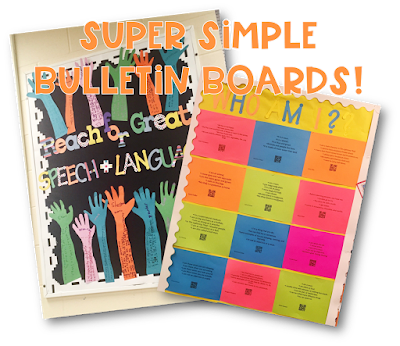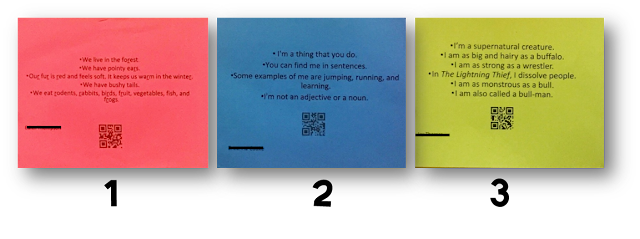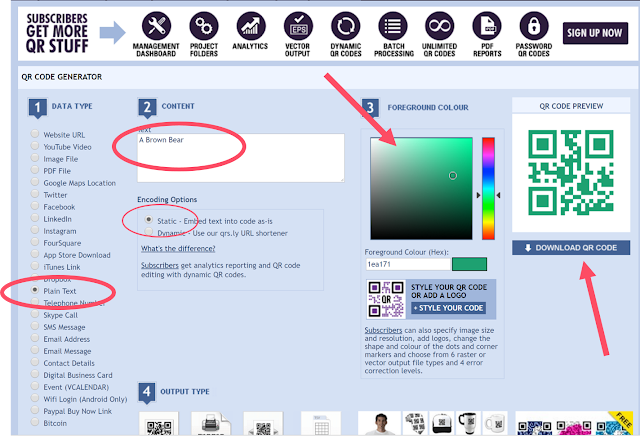If there's one thing I love in all the classrooms I see on Instagram and Pinterest, it's the beautifully arranged bulletin boards with amazing color, lettering, images, and borders...
But do we truly have time for all of that?
Do NOT get me wrong, I view those bulletin boards like a piece of art, and wish I had the talent and patience to make mine look as good!
But the reality is, I'm so involved in paperwork, planning, therapy, committee duties at my school, trainings, collaboration, behavior management, paperwork (did I say that already?), that I just don't have extra time to commit to my 4 bulletin boards (regardless of loving them dearly).
That being said, I found some really awesome quick ideas for my boards that actually incorporate THERAPY! That's a two for one deal right there!
First, I started with my Reach for Great Speech and Language bulletin board:
This bulletin board is above a large bookshelf, so I knew I wanted something that I could leave up for awhile. It's also positioned behind my main therapy table, so I thought it would be useful to have something I could continuously reference during therapy...
and VOILA!
Supplies Needed (very minimal!):
-scissors
-markers
-scrapbook, construction, scrap paper (really anything large enough to trace hand/arm on)
Instructions:
I really love when my students can take ownership for their own goals. I like to review goals with them, put them into student friendly terms (check out
these on TPT from Queen's Speech), and help them become accountable for those goals through progress monitoring sheets (I use
these).
Once I've spent some time reviewing goals with students, I'm ready to have them write their goals out so that we can place them in our speech room for easy viewing!
1. We traced our hands/arms
2. We reviewed our speech goals in student friendly terms
3. We wrote our goals out on our arms and discussed how we can reach for great speech & language!
If my student comes to speech and says, "what is it that we're working on again???" (sometimes I think it's an avoidance mechanism!)..
I can simply point to that student's hand on our board!
Next, I wanted to make an even more interactive bulletin board that incorporated student involvement. I work in a district with multiple inclusion classrooms and self-contained classrooms, so not all of my students know each other very well, even if they're in the same grade level. Something they ALL have in common, is a love of technology.
And so began the QR Code Riddles- Who Am I?? bulletin board:
I LOVE this bulletin board! I was able to address every single one of my students' goals. EVERY. SINGLE. ONE. through the use of creating QR Code Riddles
Supplies Needed:
-Astrobright paper (but that's just because I wanted to add some color!) or any cardstock/printer paper
-Printer/Ink
-Accessibility to computer/iPad for students
Instructions:
You'll want to determine what goal you'll want to address with your students in order to decide how to guide each riddle. Here are some examples of the riddles my students formulated:
Student #1 is working on the /r/ phoneme in all positions, and she LOVES animals. Her classroom science unit is focusing on habitats, and all the vocabulary surrounding the habitat unit. We were able to target both her vocabulary goal and articulation goal!
Student #2 is working on parts of speech, and distinguishing between nouns, verbs, and adjectives, as well as sentence structure.
Student #3 is working on grade level vocabulary, comprehension, and inferencing. He chose to focus on a character from his ELA unit, The Lightning Thief
Once we decided what topic or item each student was going to address, I let them work on writing up their own clues for the riddle. They jotted some ideas before working on a final copy, and the conversations and ideas turned out to be just as fun as writing the riddle!
Students in groups were able to bounce some ideas off each other, and it addressed some really great social language work, as well as opportunities for ice breakers among unfamiliar students. Many of my students enjoyed testing out their clues on their peers, which helped them determine if they needed to add more information and be more descriptive. This project lead to a very fun therapy week!
Finally, I allowed my students to type out each riddle, which proved to be extremely engaging for them (because sometimes a paper and pencil just doesn't cut it!). When it was time to create the QR code, they thought it was the COOLEST thing. I even had a student ask me to write out the instructions and website so that he could take it home to show his mom! (I ended up emailing mom, and she explained how excited he was that night, and that they generated A LOT of QR codes... talk about carryover!).
Once you follow the steps above, simply download the QR code and insert it into the file your students have typed up! It will download as a png file, so you can insert it into Powerpoint, Word, etc, just like you would a regular image/picture from online.
When it's time for students to read the riddles to each other, they can use a QR Code Reader (found on the app store) to scan the QR Code, and *poof* their answer is revealed!!
I had these bulletin boards ready to go by open house, so that students would bring parents into my speech room, introduce me/them, read the speech goals we had worked on from the first bulletin board, and then show them the QR code riddles to try to have parents guess the answer...
If my students showed me that they were using their goal with their parents (such as using the /r/ sound or using really awesome sentence structure) they earned an extra speech buck into their speech bank! (this is for a later post on my behavior management bulletin board using speech bucks!) This showed the students taking ownership for their speech goals, and also allowed the parents to see what we are truly targeting during our speech sessions, in hopes to lead to some extra carryover.
My students were THRILLED. And when else can you get parents into the speech room on open house night?! I don't know about you, but I'm generally forgotten.
It was such a huge hit, my students began asking for it each year!
I'd love to know what you think! Leave a comment below.





